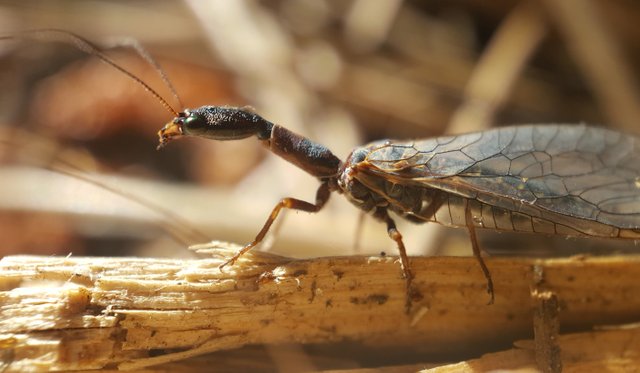
Intro
You see a fly banging repeatedly into the window, trying to get outside. “Stupid fly,” you think, “It doesn’t even understand what a window is. Flies must not be intelligent.” You summarily dismiss the fly, and continue about your day. You do some intelligent, human things.
You do some math to pay your bills. You write an email to your boss. You talk to your neighbor about politics. You think, “Humans are a lot smarter than insects.” It’s an easy conclusion to come to. The fly on the window couldn’t pay your bills or discuss the merits of their favorite political candidate. Yet, what about these tasks makes them intelligent?
When I pay my bills, talk to my boss, or vote in an election, my ultimate motivation is the same. I am concerned for my own survival in this world. I pay my bills to ensure I will have a safe place, with water and electricity. I have a boss, and must talk to him sometimes, to make money to pay my future bills. All of my actions are directed towards my survival, and that of my any offspring I may have. Going to work is, in effect, an extension of your DNA’s efforts to maintain and replicate itself. This is no different than the strange and diverse actions animals take to maintain and replicate their DNA.
Yet, beyond the most obvious connection between human and animal forms of intelligence, let’s look at the specific actions we take to ensure our survival. Language is undoubtedly a complex form of intelligence, but it’s certainly not the only kind of intelligence. We also have traits like social intelligence, the ability to read other people and groups, and physical intelligence, having great control over your body. Math is definitely intelligent, requiring a specific form of intelligence called rationalization. But really, all of these magnificent abilities are just adaptations, selected naturally through the course of evolution, to help us survive and reproduce in our environment.
Imagine, though, that humans had evolved differently. Imagine, that instead of evolving in social groups we evolved to survive as solitary creatures. Would there be any need for language? Probably not. Would that make us less intelligent? Some people would argue yes; others would say no.
For those of you who agree, that language is what makes humans intelligent, let me present the case of the humble honey bee.
Bees
Most people consider the honey bee an annoying stinging insect and nothing more. They have maybe only seen bees a handful of times. If they were unlucky, they may have experienced the painful sting of a bee trying to defend its hive. If they were really unlucky, they may have experienced a coordinated attack by the entire hive.
For those who think only humans are capable of language, I have just one question. How did the bees coordinate an attack? The correct answer is pheromones. These strong chemical signals are released after one bee stings, and they alert the entire colony.
You might say, “Sure, but that’s not language. The bees didn’t use words”. But I would disagree with you. What is a word, anyway? It is a specifically shaped soundwave we create with our vocal chords, to produce an action in another animal. If the bees produce a specific pheromone for singular purpose of conveying the idea Attack!, how is that different from us producing a sound which means the same thing? What is the difference between a bee releasing a pheromone, and an officer in the military shouting, “Attack!”?
The answer has nothing to do with the actual intelligence of the animal involved, only on the process of communicating the message. The organisms receiving the signal, in each case, can respond and join the attack upon receiving the signal.
If that doesn’t convince you that bees have at least some form of language, here’s an even better example. Have you ever heard of the bee dance? Researchers watching bees have discovered that as a bee returns from a food source, it will enter the hive and preform a strange series of movements (Chittka, 2004). Scientist studied these movements, and have deciphered that the bees are actually giving directions to the food source. A butt waggle might indicate flying straight, while flapping the wings might indicate flying higher. The bee returning from the food source will wiggle, walk, and flap its wings. (The dance is much more complex, these are just examples.) Below is an image of the bee doing the dance for a live audience.
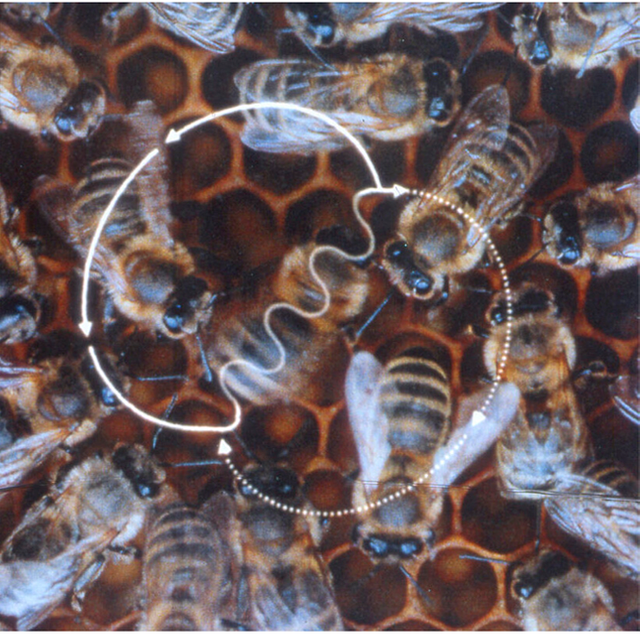
Image via Wikimedia Commons, from (Chittka, 2004)
The other bees gather around the dancing bee, and point their antennae toward her. From these movements, the bees determine the direction, distance, and path to a given food source. This could be a grove of blooming trees, or simply a dish of sugar water provided by the researchers. The other bees then take these directions, and fly directly to the food source. If you can’t draw the equivalence with spoken language, try thinking about it like sign language. Communicating with sign language as just as effective as verbal communication, as humans themselves have demonstrated.
Thus, if you are someone who believes that language is the crux of intelligence, then bees clearly pass the test. Further, it has been shown that almost all insects communicate in some way with their peers, even if it is only through touch and scent around mating season.
Some people might then argue that language itself is not intelligence. They might say that one must also have rationality. If you think this must be the key to human superiority, then there is another group of insects you should meet.
Parasitic Wasps
Wasps are typically solitary, predatory insects. A major group of wasps are known as parasitic wasps. These wasps, instead of laying their eggs inside of small cocoons or hives, lay their eggs inside of other animals. Some wasp species choose other adult insects, such as spiders or beetles. Other species of wasp specialize in preying on larva, such as caterpillars. Still other species specialize on the eggs of other insects, laying their own eggs within the larger eggs. A parasitic wasp can be seen in the image below:
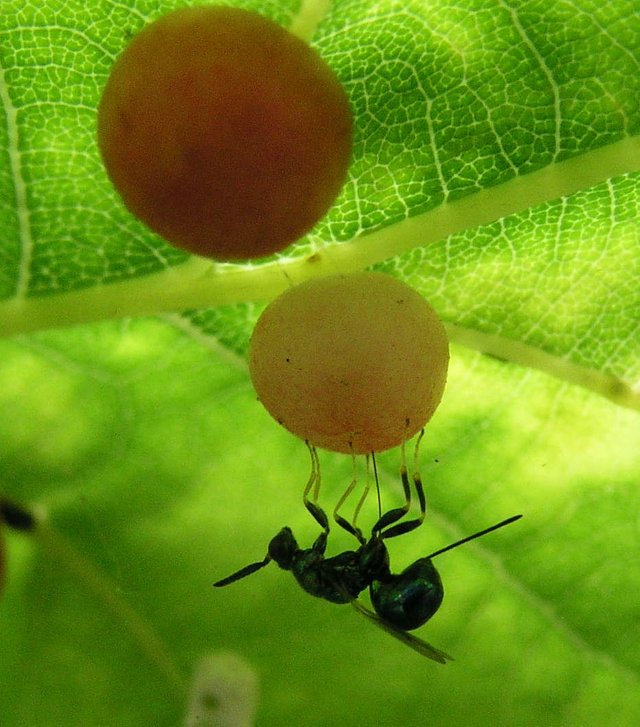
Image via Wikimedia Commons, under CC BY-SA 3.0 license. Image unaltered.
You were probably expecting me to quit there, but I’m not done. Within this group of parasitic wasps are sub-group, who specialize on the eggs and larva of other parasitic wasps. This seems like a mind-boggler, but it’s true. These secondary parasites are parasites of parasites. They lay their eggs in the same place as the primary parasitic wasp, but their larva feed on the primary parasitic wasp larva instead of the egg itself.
But strap in, folks, it’s not over yet. There are also tertiary parasitic wasps. These parasites prey on the secondary parasites, actually helping the primary parasitic wasp larva survive. You might think that these wasps would be too small to see, but scientists have actually identified a quaternary parasitic wasp. For all you visual learners out there:
Insect egg --> Primary wasp larva --> Secondary wasp --> Tertiary wasp --> Quaternary Wasp
--> = Is host for
Okay, but what does this all have to do with rationality?
Image that you are a female wasp, which acts as a secondary parasite. This means that you lay your eggs inside of the eggs of other wasps. It has been shown that females of these species not only have the ability to identify eggs from the other species, but they selectively pick only the biggest and most nutrient filled eggs. Further, upon approaching an egg the wasp will inspect the egg for damage. Then, pushing its egg-depositing ovipositor into the egg, the wasp will feel around and count how many other parasites are in the egg. Scientists have measured this behavior in detail (Evans, 1993) and have shown that wasps only select eggs with parasites below specific numbers, depending on the species.
All of the actions these wasps take when selecting an appropriate host for their parasitic young are rational actions, based on input from the environment and the wasp’s sense organs. It’s no different than a mother dropping milk on her hand first, ensuring the bottle isn’t too hot for the baby. Or the action of parents carefully selecting which house to purchase, based on their needs and the needs of their new baby.
While the above examples clearly show that insects can meet all of the presented criterion required for intelligence, there are still naysayers. If you are one of these people, you might be tempted to argue that intelligence is not just having rationality and language, but using them to an advanced degree to shape the environment around you. To those people, I present the case of the humble ant.
Ants
While many of us grew up burning ants with magnifying glasses or flooding their nests with the garden hose, it may come as a surprise that ants (and termites) are likely the most coordinated and civilized of the insects. I too can admit to these crimes, though I now hang my head in shame at the havoc I caused to these advanced miniaturized societies. You may think I’m exaggerating, but consider the daily activities of a colony of ants.
The hive organizes itself through a wide variety of chemical scents and pheromones, deposited on the ground by individual ants as they go about their business. While this might seem a strange method of passing messages, put yourself in the world of an ant. Your vision is limited, and you are one of the smallest insects in the world. Yet, the area you must explore to provide food for your colony is immense. Ants, placing pheromones as they go along, can branch out and explore the environment around the nest.
Upon finding a potential food source, the ant will quickly tear a piece off. Following her trail back to the nest, the ant will also deposit more pheromones to reinforce the strength of the trail. In the nest, the ant will show its food morsel to the other ants, who will touch it with their antennae to analyze it. These ants will determine from their experience if the object is food, and of what quality. Upon determining the morsel is food, these ants set out of the nest and follow the pheromone trail to the food source. As they go, they deposit more pheromones, expanding the scent trail into a scent highway. As they return with more chunks of food, more ants are encouraged to go.
As the food source starts to run out, the opposite starts to happen. Ants start arriving at the food source, only to find nothing. At this point, the ants will make a rational decision to scour the area for food or return to the nest. If many ants return to the nest empty handed, they will not deposit pheromone on the way back and the scent will slowly fade as the ants find more lucrative paths elsewhere.
Still not impressed by ants? Watch a group of them coordinate to take down a beetle several times their size:
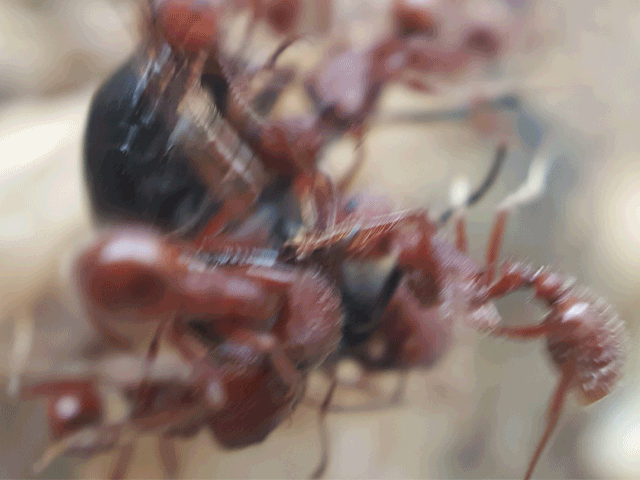
In this series of images, you can notice several things that highlight the amount of communication and coordination between the ants. Look at ant in the center of the frame. As the wriggling pile of ants and beetle moves toward the nest, this ant at first appears to be doing nothing. Her legs and jaws are locked onto the beetle, holding its legs in place. The ants to her right and left are actively dragging the bound heap. You can even see a newcomer coming in to help at the end of the sequence. This ant (seen coming in on the left), approaches the pile, feeling it out with her antennae. She senses the shape of the beetle, and the position of the other ants before pushing against the pile. As more ants reach the pile, the work is distributed equally and large insects like this can easily be controlled and taken down.
While this certainly shows the language and rationality possessed by ants, ants are capable of far more. While the above scenario applies to many species of ants, some possess much more advanced methods of gathering food. Like early human ancestors, many ants have switched from being hunter-gatherer societies, to being more advanced and supporting several types of farms. Yes, you heard that right, ant agriculture.
As seen in the series of images below, many species of ants are farmers. These ants are aphid farmers, the small black insects seen in the image. Aphids are essentially the cows of the insect world. Using their needle-like proboscis, the aphids poke into the cells of the plant they are on. They drink the contents of the cell, and move to the next cell. The ants, like ranchers herding cattle to a new pasture, move the aphids around to different plants as the aphids eat their way through them.
Further, the ants actually “milk” the aphids. Though it is not milk, the aphids do excrete a sugary substance. Not only do the ants harvest this product, but the aphids only excrete this substance when stimulated by the antennae of an ant. The first image below shows an ant shepherd, watching carefully over his flock of aphids.
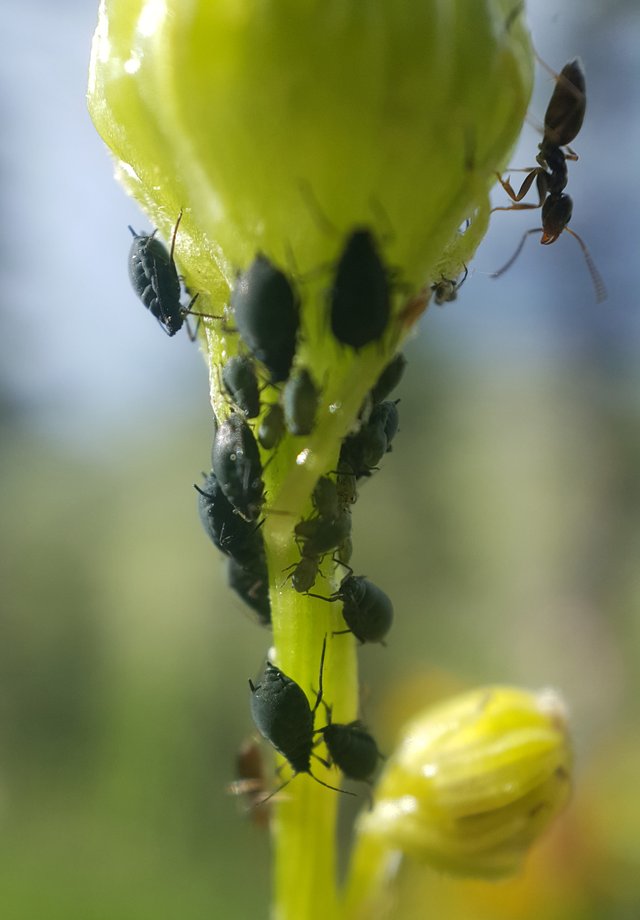
Now, take a look at this second image. The ant has gone to attend one of the aphids in the middle of the herd. She lifts the aphid by the back legs, stroking its belly with her antennae. Thus stimulated, the aphid will begin secreting a sugary substance. She will take her fill, then return to the nest to feed other ants, including the newborn larva. Like a good farmer, she will then return to the flock to ensure they are protected while they feed on the plant. Check it out! This is no joke!
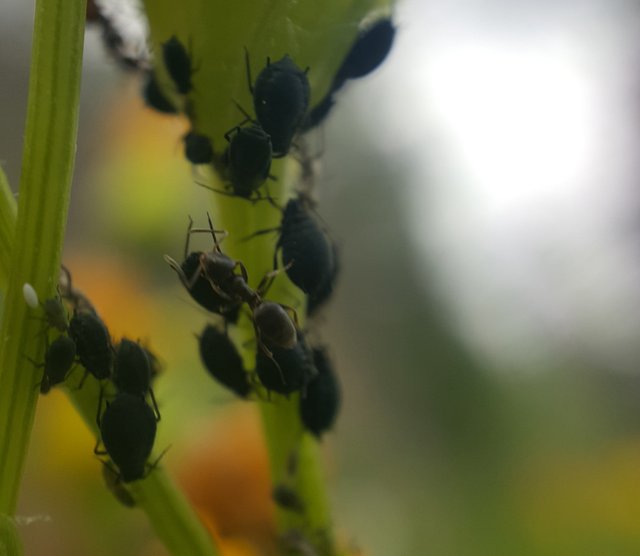
Other ants farm other things, such as fungus. Ants that use this method harvest leafy greens from above ground, then take the cuttings to underground chambers. They are seeded with the spores of a fungus, and slowly rot. The fungus sprouts, growing on the dead leaves. As the fungus grows, the ants harvest and eat it as a continual source of food.
It has been shown, by Jared Diamond among others, that humans only became advanced societies after the dawn of agriculture (Diamond, 2005). Farming allowed humans to harvest more food than available via hunting and gathering alone. In turn, this allowed for the creation of a bureaucracy, and for some humans to quit producing food and focus on other areas such as math and science. In turn, we became the advanced technological creatures we are today.
While these ants can’t yet build their own tractors, it is clear that they are farming in the most standard definition of the word. These ants clearly have the basis of a simple, if not incredible, agricultural system. That is why, when I think of all the ant colonies I destroyed as a rambunctious youth, I shudder. Had I unknowingly destroyed the seeds of a future Intelligent Civilization?
The sad reality is that many of these seeds are terminated every day, though not by children destroying single mounds. Though children should be taught to respect all life, the real culprit is the destruction of the environment and the loss species in the process. While many people are rightly concerned about the effects of climate change and habitat destruction on the human species, we should be equally concerned about the potential forms of sentient life we are losing.
Other Intelligent Insects
Believe it or not, the insects described above all fall into only one Order of insects, the Hymenoptera. There are around 30 different orders of insects, and many of those are intelligent. Of the millions of species of insect, the Hymenoptera represent only 125,000 species (Brusca & Brusca, 2003), probably less than 1%. Other insects like beetles, grasshoppers, flies, and praying mantises having their own unique forms of intelligence. Creatures like spiders (which are technically arachnids, not insects) also show high levels of intelligence, weaving webs and hunting specific prey using seemingly rational methods. Below are several more examples of intelligence within the insect world, found in my backyard.
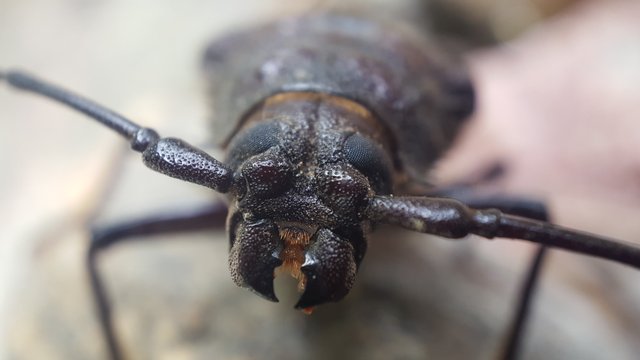
Pictured above is a Long-horned Pine Borer, named for its large, armored antennae and the fact that it burrows into pine trees to lay its eggs. The female, after emerging to reproduce, finds a suitable tree and chew through the bark with those massive chompers. The small hairs you can see around the mouth allow the insect to feel the bark, and help determine if the tree will be suitable for the offspring. They will also analyze the tree for other beetles, selecting trees with the fewest occupants. The small eggs will hatch after being laid under the bark, and eat their way through the wood of the tree. After spending much of their life in this form, they undergo metamorphosis, and their priorities change. They emerge as beetles, and begin seeking a mate beyond the confines of their tree, starting the cycle over.
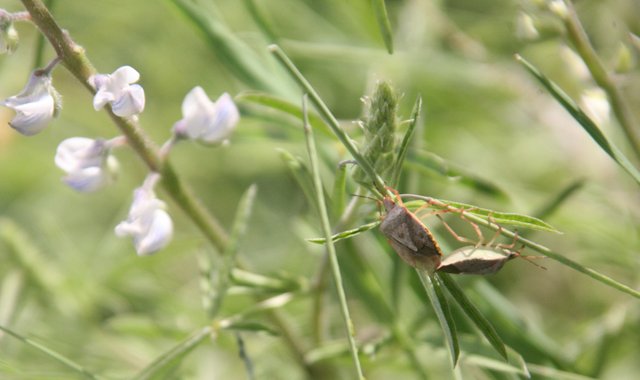
Another species of beetle can be seen in the image above, in the difficult and precise act of mating. After locating each other over vast distances using pheromones, the female beetle has accepted the male. However, the act of mating itself requires a relatively high level of intelligence in these organisms. They participate in a series of symbolic movements bobbing and weaving, before moving into the right position. Given that the beetles are not facing each other during the act, the beetles lock their back legs together to hold themselves in position until the sperm has been deposited in the female. Once they separate, the female will make her way to the underside of a leaf. She will carefully examine the leaves, selecting one large and strong enough to support her brood.
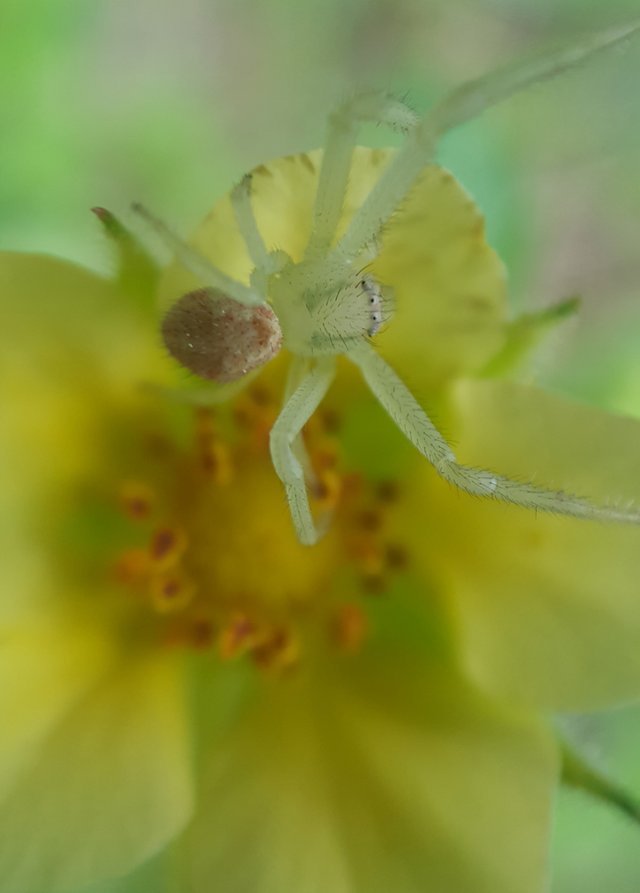
This final image shows a camouflaged spider, carefully waiting on a flower for a nectar-feeding insect to come along. The spiders, like the prey they are hunting (bees and flies), can sense both the ultraviolet colors specific flowers give off, as well as the electrical properties of the flower itself. The nectar found within flowers has unique electrical properties, which pollinators sense to direct them to the most lucrative flowers. This spider, sensing that the flower is both a desired species and full of nectar, carefully climbs into position and spreads its arms across the entrance to the flower. Thus, this spider has evolved to hunt without a web, a skill that demands observation, recognition, and rationally choosing its hunting spot.
Conclusion
Through this post, I hope I have given readers a better understanding of the natural world around them. Animal intelligence can take many forms, but that in no way means animals are less intelligent than us. In our human-centric view of the world, we tend to discredit anything that is different from ourselves. We pretend that it is somehow lesser, regardless of how successful the organisms using it are. Did you know that in an acre of fertile soil, there are more organisms than the entire human population? (Evans, 1993). How can we say we are the most successful organism?
In time, it will be shown that there are many levels of intelligence in all animals, and each species has developed strategies to fit their needs. In Europe, during the age of rampant Imperialism, people often took a Euro-centric view of the world, and by default viewed their languages and customs as superior to those they subjugated. As a result of their racism and prejudice, they wrongly assumed they were more intelligent than the others. Recent science, and common sense, tell us that these biases are unfounded. All people have the potential to be vastly intelligent, regardless of race, creed, or socioeconomic status (Plomin & Petrill, 1997).
Likewise, people who try to argue against animal intelligence will soon find themselves facing a similar situation. As we learn more about the natural world, we are bound to find that our naive preconceptions of intelligence excluded the vast majority of intelligence already found in the animal kingdom.
Until next time,
-Gabe
Bibliography
Brusca, Richard C., and Gary J. Brusca. Invertebrates. 2nd ed. Sunderland, Mass: Sinauer Associates, 2003.
Chittka, Lars. “Dances as Windows into Insect Perception.” PLoS Biology 2, no. 7 (July 13, 2004): e216. https://doi.org/10.1371/journal.pbio.0020216.
Diamond, Jared M. Guns, Germs, and Steel: The Fates of Human Societies. New York: Norton, 2005.
Evans, Howard Ensign. Life on a Little-Known Planet. New York, NY: Lyons & Burford, 1993.
Plomin, Robert, and Stephen A. Petrill. “Genetics and Intelligence: What’s New?” Intelligence 24, no. 1 (January 1997): 53–77. https://doi.org/10.1016/S0160-2896(97)90013-1.
Romanes, George J. Animal Intelligence. The International Scientific Series. New York: D. Appleton and Company, 1884. https://www.amazon.com/dp/B008VE20PK/ref=dp-kindle-redirect?_encoding=UTF8&btkr=1.
Thanks for reading my post. All images not credited directly were taken by me, for the purposes of this writing.
This is the first in a long series on Animal Intelligence. Follow me to get the rest of the series, and other articles on the philosophy of science in general. If you have suggestions, comments, or questions, leave them below. I will try to answer as many as I can. I work hard to produce quality content for the Steem platform, and am always looking to improve. Thanks for the support, and happy Steeming!
Thanks Gabe :) I used to be the curator of a National History Museum responsible of the arthropods section. I spent a couple of years diving into this world and discovered the wonders of the way insects, crustaceans, spiders and alike interact with the world. Nothing has been the same since. It's not easy to convey complex scientific content, especially about creatures that are often considered "stupid" or "disgusting" or "dangerous". Keep writing please and I'll keep reading.
Downvoting a post can decrease pending rewards and make it less visible. Common reasons:
Submit
That's awesome! Glad you enjoyed my post. Thanks for reading.
Downvoting a post can decrease pending rewards and make it less visible. Common reasons:
Submit
I loved this post. This is brilliant perspective not on different strategies animals employ to survive, but also how we take the idea of intelligence for granted. I loved what you did with honey bee and language. We have a honey bee lab here, headed by Axel Brockman, a part which is trying to understand the language of honeybee dance. I once had a curious question about it - say if I show a forager bee the location of food. It goes back and dances. But in the meantime I remove the food from this place, would this bee lose credibility in the colony? So in social structure are these insects smart enough to remember which individual gets more credible information.
I think intelligence needs to be defined more clearly. It is rather ability to find solution to novel problems and not just limited to writing a math test. I think you could covered that point in an interesting way here. Anyway, thanks for sharing this.
Downvoting a post can decrease pending rewards and make it less visible. Common reasons:
Submit
Hey, Thanks for reading!
Cool idea about credibility between bees. If they ever test it, let me know!
Downvoting a post can decrease pending rewards and make it less visible. Common reasons:
Submit
Animal intelligence is a complicated subject and the content I just read proves so. I had some new insights regarding some insect behaviors here and it's good to read about informative content on the platform. Ants and Bees are really awesome in their own intricate communications system. This subject has a lot of uncharted waters and we can learn a lot from it and even find ways to improve our own communication systems.
Downvoting a post can decrease pending rewards and make it less visible. Common reasons:
Submit
Congratulations @gabebuckley! You have completed the following achievement on the Steem blockchain and have been rewarded with new badge(s) :
Click here to view your Board of Honor
If you no longer want to receive notifications, reply to this comment with the word
STOPDo not miss the last post from @steemitboard:
Downvoting a post can decrease pending rewards and make it less visible. Common reasons:
Submit
This is really an interesting writing. i've always seen the insects as a category of intelligent animals because of their mode of community. An example of insect community that amuses me is that of soldier ants; scatter them now and give them few minutes they will assemble back to their single file, attack them with fire and the able ones will pick up the injured ones and leave the dead- what an amazing intelligence! thanks for the post, you did a good job.
Downvoting a post can decrease pending rewards and make it less visible. Common reasons:
Submit
What a wonderful way to look at intelligence; from the insect point of view
I really enjoyed this piece very much as it was really enlightening and interesting as well. Keep up the good work, hope to see more from you
Downvoting a post can decrease pending rewards and make it less visible. Common reasons:
Submit
Hi @gabebuckley!
Your post was upvoted by Utopian.io in cooperation with @steemstem - supporting knowledge, innovation and technological advancement on the Steem Blockchain.
Contribute to Open Source with utopian.io
Learn how to contribute on our website and join the new open source economy.
Want to chat? Join the Utopian Community on Discord https://discord.gg/h52nFrV
Downvoting a post can decrease pending rewards and make it less visible. Common reasons:
Submit
Congratulations @gabebuckley! You have completed the following achievement on the Steem blockchain and have been rewarded with new badge(s) :
Click here to view your Board of Honor
If you no longer want to receive notifications, reply to this comment with the word
STOPDo not miss the last post from @steemitboard:
Downvoting a post can decrease pending rewards and make it less visible. Common reasons:
Submit
This post has been voted on by the SteemSTEM curation team and voting trail in collaboration with @utopian-io and @curie.
If you appreciate the work we are doing then consider voting all three projects for witness by selecting stem.witness, utopian-io and curie!
For additional information please join us on the SteemSTEM discord and to get to know the rest of the community!
Downvoting a post can decrease pending rewards and make it less visible. Common reasons:
Submit
I always like the fact that we, humans, are nothing more than animals but yet we can develop the technology to share ideas, in almost real time, from around the world... super cool article.
Downvoting a post can decrease pending rewards and make it less visible. Common reasons:
Submit
Nice post about the intelligence of some organisms!
It is super intersting the different ways of communication that organisms have to have survival. Funnily enough, there are plenty of ways they can achieve it by communicating it to different parts or organisms of the society.
My favourite example you put was the one of the bees. Strong pheromones after a bite & dancing patterns for the rest of the hive to communicate? It is weird. It makes you wonder about the nature of "information" as such. For them means food, or attack. For us, means nothing. As if they were different languages.
Pretty cool if you ask me! :D
Downvoting a post can decrease pending rewards and make it less visible. Common reasons:
Submit
Wonderful blog. Impressive pictures. I've written on bees, ants and worms for Steemit, so obviously this subject interests me. Your writing is so clear, your familiarity with the subject so fluent, that the article was a pleasure to read.
Downvoting a post can decrease pending rewards and make it less visible. Common reasons:
Submit
Congratulations @gabebuckley! You have completed the following achievement on the Steem blockchain and have been rewarded with new badge(s) :
Click here to view your Board of Honor
If you no longer want to receive notifications, reply to this comment with the word
STOPDo not miss the last post from @steemitboard:
Downvoting a post can decrease pending rewards and make it less visible. Common reasons:
Submit
Thank you for this article which is showing us that the intelligence is not the way we thought so far. And it also proves that we are not as intelligent as we might think over other living beings. Most of the time we, as the humans make a categorization on the animals by using our intelligence testing methods like IQ tests. Thus we think that we are the most intelligent ones on the planet and the monkeys are the second, octopuses are the third..etc. However it is very weird to make such reasoning like this. In our daily lives we clearly see that other animals can find out really considerable solutions to survive.
Downvoting a post can decrease pending rewards and make it less visible. Common reasons:
Submit